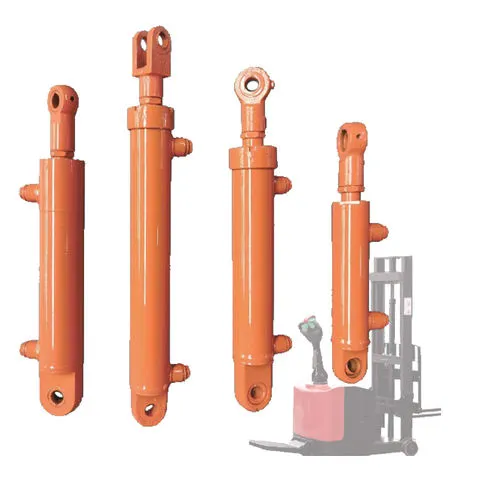Understanding the Electric Forklift Oil Hydraulic Cylinder
2025-01-21
Electric forklifts are increasingly becoming the go-to solution for warehouse operations, offering significant benefits such as quieter operation, lower emissions, and reduced maintenance costs compared to their internal combustion counterparts. One key component that contributes to the efficiency and reliability of electric forklifts is the oil hydraulic cylinder. This hydraulic component plays a vital role in lifting, tilting, and stabilizing the load, making it essential for the smooth operation of the forklift. In this blog, we’ll explore the role, features, and benefits of the electric forklift oil hydraulic cylinder.
What is an Oil Hydraulic Cylinder in an Electric Forklift?
An oil hydraulic cylinder in an electric forklift is a mechanical device designed to convert hydraulic energy (oil pressure) into linear force and motion. It is part of the hydraulic system, which powers the lift mast, tilt mechanism, and other vital functions of the forklift. The cylinder operates by the pressure created by hydraulic oil being forced into a chamber, which then moves a piston inside the cylinder, providing the lifting or tilting motion.
Hydraulic cylinders are an integral part of any material handling equipment, but they are particularly critical in electric forklifts where precise control and smooth operation are necessary for efficient performance in tight, high-volume warehouse spaces.
Key Features of the Electric Forklift Oil Hydraulic Cylinder
1. High Efficiency: The hydraulic cylinder works efficiently with minimal energy consumption, providing the precise force needed to move heavy loads without consuming excessive power, which is essential in electric forklifts where battery life and energy usage are key concerns.
2. Compact Design: Hydraulic cylinders are designed to be compact yet powerful, allowing them to fit in the restricted spaces of the forklift's mast system. This ensures the forklift remains maneuverable even when handling large loads.
3. Durability: Oil hydraulic cylinders in electric forklifts are built to withstand high levels of pressure and constant use. They are made of durable materials like high-strength steel and are often treated to resist corrosion, ensuring a long lifespan even in challenging warehouse environments.
4. Smooth Operation: These cylinders enable smooth, controlled movement of the mast, forks, and tilt mechanism, making the process of loading, unloading, and stacking more efficient and less jerky, which is important for both operator safety and reducing load damage.
5. Sealed System: The hydraulic cylinder is a sealed system, which minimizes the risk of leakage, a common concern in hydraulic systems. A sealed cylinder ensures that the hydraulic oil remains contained, reducing maintenance issues and improving operational safety.
Applications in Electric Forklifts
The oil hydraulic cylinders in electric forklifts are responsible for several critical functions:
1. Lift Mechanism: The most obvious application is in the lifting mechanism. The cylinder provides the force needed to raise and lower the forklift’s mast, enabling the forks to carry loads to various heights. This is crucial for stacking pallets or accessing high storage shelves.
2. Tilt Function: The tilt function allows the operator to adjust the angle of the forks for more efficient load handling. The hydraulic cylinder controls the tilt motion, allowing operators to position loads with precision.
3. Stabilization: In addition to lifting and tilting, hydraulic cylinders help stabilize the forklift, particularly during lifting tasks. Stability is critical when dealing with heavy loads or navigating through tight spaces in a warehouse environment.
Benefits of Electric Forklift Oil Hydraulic Cylinders
1. Energy Efficiency: Unlike internal combustion forklifts, electric forklifts are powered by batteries, and hydraulic systems in these forklifts are designed to be energy-efficient, which helps to extend battery life. The efficiency of the oil hydraulic cylinders ensures that more energy is directed toward lifting and handling materials, rather than wasted on excessive power consumption.
2. Cost-Effective: Hydraulic systems are generally easier and cheaper to maintain than more complex mechanical systems. The long lifespan of hydraulic cylinders also contributes to lower maintenance and replacement costs over time.
3. Improved Operator Comfort and Safety: The smooth, precise operation of the hydraulic cylinders ensures that the forklift responds predictably to operator inputs, minimizing the risk of accidents and improving overall comfort during operations.
4. Environmental Benefits: Electric forklifts with hydraulic systems are more environmentally friendly than gas-powered machines. The use of hydraulic cylinders in these machines ensures that tasks are completed efficiently with fewer emissions, contributing to a cleaner, greener warehouse environment.
The electric forklift oil hydraulic cylinder is a vital part of the machinery that powers modern material handling operations. With its compact design, durability, and efficient performance, this hydraulic cylinder allows electric forklifts to deliver smooth, controlled lifting and tilting, making them a perfect fit for high-density, fast-paced environments. As electric forklifts continue to gain popularity, understanding the role of the hydraulic cylinder in ensuring operational efficiency and safety is crucial for anyone involved in warehouse or logistics operations.



